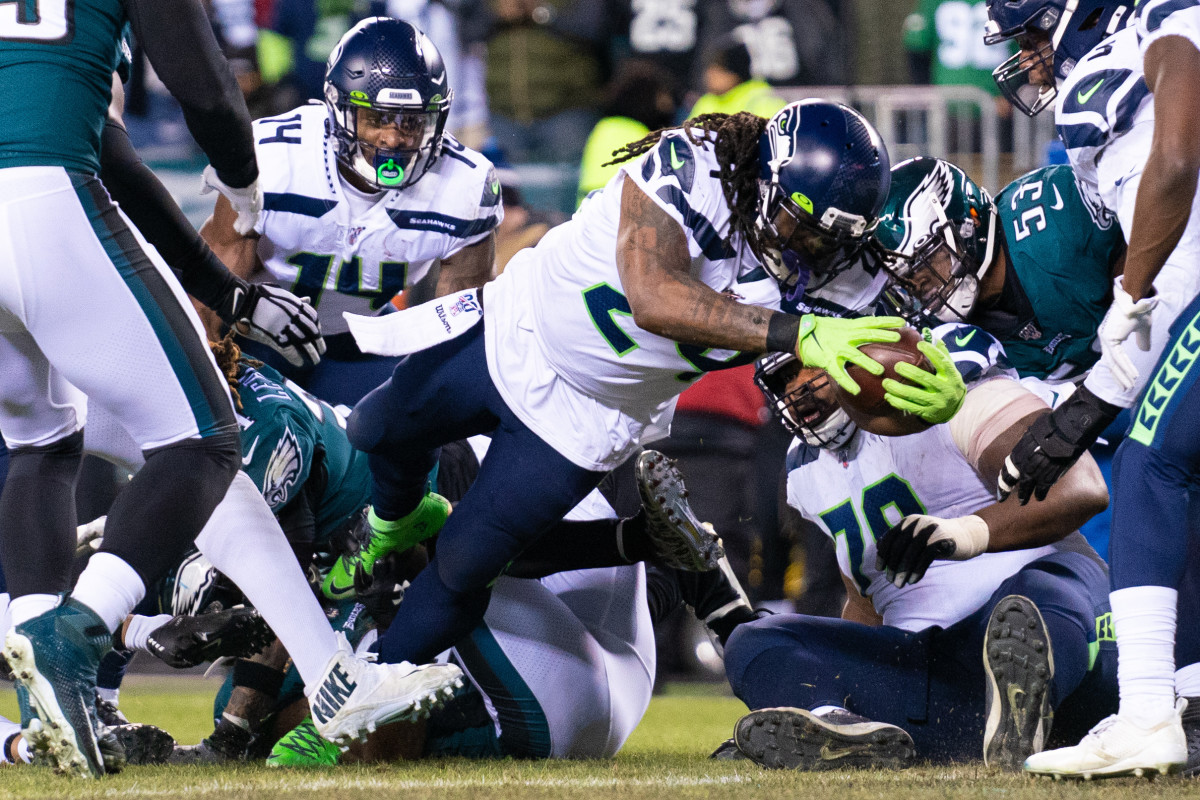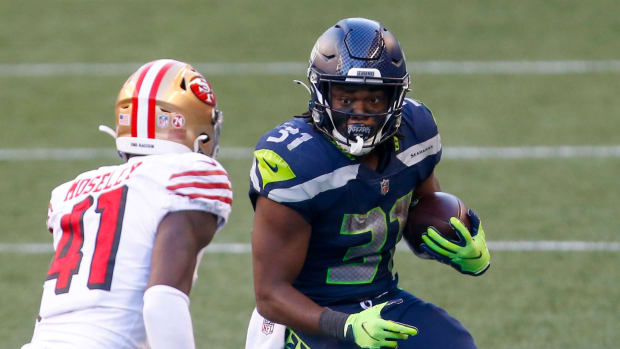Run Game Must Awaken for Seahawks to Advance Past Packers

At times during his tenure, coach Pete Carroll and his coaching staff have been criticized for not adjusting quickly enough when opponents slow down the run game, waiting too long to put the ball back into Russell Wilson’s hands.
During last Sunday’s 17-9 wild card win in Philadelphia, however, Carroll and offensive coordinator Brian Schottenheimer proved capable of adapting when the run game wasn’t working. With Fletcher Cox and company stuffing Marshawn Lynch and Travis Homer, Seattle dialed up 21 pass plays on their final 28 snaps of the first half.
“We’re always going to have runs ready to go,” Schottenheimer said on Thursday. “And then some of it is feel. Some of it is play callers feel, some of it is situation. Russ was playing really well. Our guys were getting open, that certainly helped. We were struggling to run the ball a little bit, which that doesn’t happen very often.”
After first down throws netting 64 yards from Wilson to DK Metcalf and David Moore moved the Seahawks inside the Eagles 10-yard line, Lynch eventually powered his way into the end zone on a five-yard touchdown run to put his team up 10-3 heading into the break.
Wilson continued to be the driving force for Seattle’s offense in the second half, hooking up with Metcalf for a 53-yard touchdown on a deep post route. He finished with 325 passing yards on just 18 completions, averaging nearly 11 yards per attempt.
Adding to his magnificent performance throwing the football, Wilson also led Seattle with 45 rushing yards, including two separate 18 and 22-yard runs for first downs.
But the rest of the Seahawks’ rushing attack remained under wraps during the final two quarters. With Cox seemingly blowing up each play before it could get started, Lynch and Homer weren’t able to find any running room at all, combining for 19 yards on 17 carries and averaging barely over a yard per touch.
Reviewing film, Schottenheimer chalked up Seattle’s struggles getting going on the ground to a combination of great defensive play by Cox and the Eagles as well as poor execution up front by the offensive line.
“He [Cox] really early in the game was causing some problems knocking people back and getting penetration which hurt our ability to get some things started in the running game. The line of scrimmage wasn’t very clear. Our fits weren’t very good. We had some double teams, trying to get guys moved off the spot. Our double teams weren’t fitted together. When you’ve got two guys trying to move one, it’s all based on how you get your bodies aligned. We were off with that a little bit.”
Prepping for a divisional round matchup against the Packers, the Seahawks can’t afford similar pitfalls this weekend against a defense that ranks among the league’s worst defending the run in several key advanced stats.
Stunningly, defensive coordinator Mike Pettine has deployed dime packages with six defensive backs on the field for 74 percent of Green Bay’s defensive snaps this year. While that’s helped the unit rank among the NFL’s best defending the pass, it hasn’t helped slowing down the run.
The Packers will enter Sunday’s playoff contest with the 23rd ranked defense in DVOA, 30 in success rate, and 30 in EPA (expected points added) per play. From a traditional stats standpoint, they ranked 23rd in opposing rushing yards (1,921), ranked 24th in yards per carry (4.7), and gave up 15 rushing touchdowns.
Most recently, Green Bay allowed Detroit, who was on its third quarterback in David Blough, to rush for 171 yards and nearly seven yards per carry in Week 17. If not for late heroics by quarterback Aaron Rodgers, the Packers likely would’ve lost primarily due to their struggles defending the run.
In their three losses, the Packers surrendered 447 rushing yards and six touchdowns to the Eagles, Chargers, and 49ers.
Dealing with a myriad of injuries along the offensive line and in the backfield, the Seahawks may not be positioned to fully capitalize on this advantage. But Schottenheimer and Carroll haven’t been quiet about their intentions of using Lynch more in his third game out of retirement.
“Give credit to Marshawn for the way he’s attacked this thing,” Carroll said on Monday. “He’s really going for it. He’s doing everything our fans would hope he would do. He’s trying to be everything in all aspects of it. He’s deserving of seeing some more reps. That’s all.”
Lynch has found the end zone twice since signing prior to Week 17 in the aftermath of Chris Carson’s season-ending hip injury, but he’s been held to 41 rushing yards on 18 carries. Now in his third week of practice, Seattle hopes feeding him more often will help neutralize an excellent Green Bay pass rush headlined by Za’Darius Smith and Preston Smith, who combined to produce 25.5 sacks this year.
For Seattle to advance, Wilson will need to be on top of his game once again and the team will go as far as he can take them. The Packers have shown themselves vulnerable to explosive pass plays, giving up 15 passes of 40 yards or more this year, the second-highest total in the league. Schottenheimer will have to pick his spots to have his quarterback take downfield shots accordingly.
But there’s no sugarcoating it – the Seahawks won’t snap an eight-game losing streak at Lambeau Field if they can’t get their rushing attack untracked against a defense that dares opponents to run. Asking Wilson to drop back 40-plus times behind an injury-marred offensive line and allowing the Packers’ edge rushers to pin their ears back would be a surefire recipe for a season-ending defeat.





